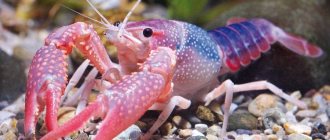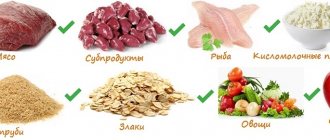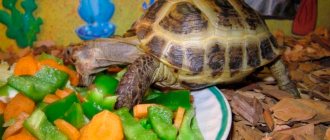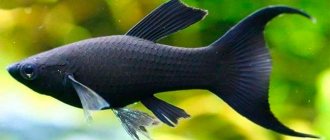To ensure that the purchased exotic reptiles grow healthy and develop well, you should find out what to feed the red-eared slider and how to diversify the diet before purchasing it. It is better to stock up in advance on those products, plants and dry food that are needed.
What to feed a red-eared turtle at home?
Feeding the red-eared turtle does not cause any particular difficulties; this type of reptile is omnivorous; the main thing is to provide it with a balanced diet, in which up to 70% are animal products. Like most predators, the reptile should also be fed plant foods, which will help fill the body with vitamins and microelements. From it the turtle receives calcium for the development of a strong and healthy shell. The diet of red-eared turtles living in an aquarium consists of the following components:
- Animal feed - meat, fish and seafood, insects, snails, worms, caterpillars.
- Plant foods - grass, fruits and berries (seedless), vegetables, mushrooms, aquarium plants.
- Artificial feed - purchased, dry, balanced mixtures.
How to feed a red-eared turtle with dry food?
Often, reptile owners, when thinking about what to feed red-eared turtles, prefer dry food, sold in pet stores in the form of granules, tablets, capsules or flakes made from dried crustaceans. It should be borne in mind that dry food can be used infrequently, adding to the main diet in the form of a treat.
If you decide to feed your red-eared turtle dry food, you can dilute it with small meat or fish pieces, add algae or other plant products. Do not accustom your pet to one type of dry food; periodically change its composition and manufacturer, choosing well-known, proven brands. Pay attention to the purpose of dry food; some types are used as primary nutrition, some as an energy supplement, as a preventive measure against rickets or to maintain immunity.
What fish should you feed your red-eared slider?
Quite rightly, some owners raise the question of what kind of fish can be fed to red-eared turtles. Not every type of fish is suitable for use in the diet of these reptiles. It is better to feed the red-eared turtle with freshwater species of fish, they are less fatty, but you can also give them sea fish - after soaking it in water and boiling it.
Before feeding your red-eared turtle fish, remove large bones from it and cut into small pieces. Red-eared turtles will not refuse seafood: mussels, shrimp, squid, crabs - they are bought fresh or frozen in the store. To prevent parasites from entering the body of reptiles, it is better to lightly boil fish and seafood or at least pour boiling water over them.
What kind of meat should I feed my red-eared slider?
When feeding turtles, give preference to lean meats:
- beef;
- horse meat;
- rabbit meat;
- lean lamb;
- offal.
To the question whether it is possible to feed a red-eared turtle chicken, the answer is unequivocal - it is possible, especially chicken liver. By giving liver to reptiles once every 7-10 days, you don’t have to worry about a lack of vitamins. The types of meat should be changed periodically, since the protein content in different types is different. It is even better to alternate meat food with fish food, this will eliminate the possibility of rickets.
What vegetables can you feed your red-eared slider?
Let's consider what you can feed a red-eared turtle besides food, meat and fish. Plant crops, especially vegetables, diversify the reptile menu. The more varied you feed your red-eared turtle with vegetables, the more different microelements and vitamins it will receive. The best vegetables are:
- zucchini, eggplant;
- tomatoes;
- carrots and beets;
- Bell pepper;
- cabbage.
When adding vegetables to the food of red-eared turtles, do not overdo it with any one type, it is better to use a little of everything. Vegetables do not contain protein, so they do not contribute to the intensive growth of reptiles; it is better to include them in the diet for older turtles. Do not feed spoiled or spoiled food to animals; this will cause them distress and poisoning.
Mineral and vitamin supplements
A young reptile needs calcium during the period of active growth, formation of the skeleton and shell. Every day there should be a pinch of bone meal in the diet; it is added to the main feed. Adults should be given 1 teaspoon of bone meal once a week. This supplement is sold at a pet store or at a market that sells grain for poultry.
As a substitute, you can use eggshells ground in a coffee grinder.
Pet stores offer a large selection of vitamin supplements for red-eared turtles. They must be given in strict accordance with the recommendations on the packaging.
An expired vitamin supplement can become poisonous to a turtle; you need to pay attention to this when purchasing and storing vitamins.
Bone flour
Diet of the red-eared slider
The diet of red-eared turtles is compiled taking into account the fact that this type of reptile belongs to predators, therefore the main element in their menu is animal food, and plant food is used as a supplement in the amount of 25-30% of the total food. When developing a diet, the age of the pet is also taken into account; for the diet of reptiles under one year old, use those products that contain more protein. The nutritious diet is divided into winter and summer, while fresh vegetables can be replaced with frozen foods or dry food.
Feeding with artificial feed
This is the best choice for busy people who do not have time to prepare a diet for a turtle or cut up food. Pet stores have special balanced food for red-eared turtles in tablets, granules, flakes and capsules. In fact, they are food for fish, but improved taking into account the needs of the reptile's body.
There are times when a turtle does not like the pungent smell of such food; it turns away from artificial food, but after a while it still gets used to it. Its main disadvantage is the high price.
How often should you feed your red-eared slider?
The question raises a lot of controversy: how many times a day to feed a red-eared slider, experts advise, based on the age of the reptile, its size and the composition of its diet. Young animals need one or two meals a day, in some cases additional feeding is necessary; it is better to consult a veterinarian about this. It is recommended to feed one- and two-year-old children every other day; for older reptiles, older than two years, gradually switch to one feeding every two, and often three days. At the same time, carefully monitor the animals; underfeeding is harmful, as is overfeeding.
Plant-based food
Plant foods are necessary for all turtles, but as they age they make up the majority of their diet.
Grass
Animals love plantain, clover, vetch, dandelion leaves and rhubarb. In addition, they can be given lawn grass, coltsfoot, sprouted barley and oats.
Fruits and berries
It is recommended to cut plums, apples, pears, bananas, peach, mango into small pieces and offer them to the turtle as a treat. Tangerine, orange, apricot and melon are also suitable for feeding animals.
Aquarium plants
It is preferable to plant duckweed, spirogyra, water beetle, and pond algae. The turtles do not allow the plants to grow even a little - they are instantly eaten. You should refrain from planting elodea! The plant secretes poisonous sap and poses a danger to animals.
Vegetables
The diet should include bell peppers, cucumbers, tomatoes, zucchini, and eggplants. You can’t do without pumpkin, radishes, legumes, carrots and beets. Broccoli, celery, and dry seaweed are given as additional food.
Mushrooms
Pieces of boletus, champignons, and russula are recommended to be given to animals no more than once a week.
Attention!
Human food is not suitable for turtles! They will also happily eat food intended for other animals, but it will not benefit the turtles. It is forbidden to feed citrus peels or give berries with seeds.
What should you not feed your red-eared slider?
Feeding a red-eared slider at home is not difficult, you just need to keep in mind that not all foods on your table are acceptable for reptiles. Thus, the issue of feeding turtles eggs causes controversy among owners; opinions are divided between those who advise giving only the yolk, and those who do not recommend the use of this product at all. It is not recommended to feed reptiles with bread, it causes bloating, loss of appetite, and they have to be put on a starvation diet for several days.
Carefully examine the grass, leaves, and aquarium plants that you give to your pets; they may contain poison. Turtles pull everything into their mouths indiscriminately, like children, so they do not recognize which plant is useful and which will be harmful and even lead to death. It is better to heat the meat of poultry, animals and fish, at least briefly, so as not to cause salmonellosis and not to introduce parasites.
When thinking about what to feed your red-eared turtle, it is very important to understand that the overall health of your pet, the development and condition of the shell depend on a balanced and proper diet and compliance with the feeding regime. Observing the animal's appetite and behavior, choose a rational complex for it, this will save your pet reptile from health problems.
How long does a marsh turtle live?
Proper care will allow a turtle to live in captivity for up to 30-50 years, and, according to some scientists, a turtle can outlive a person.
Reptile breeding
In the spring, the breeding season begins in the natural environment. Males and females over 6 years old, whose shell reaches more than 9 cm, are able to move far from a river or swamp, but the act of mating, one way or another, occurs near water. What’s surprising is this: the inseminating liquid is stored in the reptile’s body for a whole year or more, which often leads to “unexpected” laying of eggs after several months of the petiole being at home with the new owner.
Egg laying usually occurs from late spring to mid-summer. Three times, turtles lay eggs in holes dug in the ground, at a depth of up to 10 cm. The eggs look like this: the shell is white, oblong, weight up to 8 g. From 8-19 eggs, small turtles will hatch in 2-3 months.
If you are breeding pets at home and want to influence the sex of a marsh turtle, carefully monitor the temperature throughout the incubation period. When the thermometer is below 27 degrees, male turtles are born; at 30 degrees or more, female turtles are born. In intermediate indicators, it is possible to obtain cubs of both sexes.
So, you have learned how to care for a swamp turtle if you become its owner, what to feed it and how often to do it, how to create a comfortable environment and breed reptiles, what ways to protect yourself from aggression and how to take care of your pet’s health. The better you take care of your girlfriend, the longer and better her life will be. If you are not sure that you are able to strictly follow all the advice, simply do not get such an unusual and capricious pet. And if you have already decided, then be responsible.
About little red-eared turtles
Almost all future owners of turtles want to get them when they are still small - cute, touching and funny. But raising such a baby to the average size of a one-year-old is not easy: the mortality rate in babies is very high. And most often - due to improper handling of them.
So what not to do?
- Remove the yolk sac on the plastron from small animals yourself.
- Create stressful situations.
- Take the extra one at a time.
Living conditions need to be made as comfortable as possible. What to feed baby red-eared turtles? Exclusively food of animal origin: 70% small lean fish and 30% by-products, insects, squid, shrimp, etc.
A terrarium for a red-eared turtle of any age should be placed so that it is not exposed to direct sunlight or drafts. But unlike adults, babies need a different temperature regime: water - 26-27 degrees, land - 32 degrees.
Description of red-eared turtles and species
Red-eared turtle photo
Red-eared turtles are born with a shell length of only 30 mm and have a very attractive bright color. In the first 1.5 years, the turtle reaches a size of 75 mm. After which the growth rate decreases and on average the growth is 10 – 15 mm per year. Individuals are characterized by the presence of distinct red or yellow-red spots on both sides of the head. The shell and skin are olive, olive-brown or green with yellow stripes. The shape of the shell is oval. Legs with large claws and membranes between the toes.
This species cannot be classified as ornamental, since the average size of the freshwater red-eared turtle is from 125 to 289 mm, however, there are records of individuals reaching a size of 350 mm. In the wild, the red-eared turtle lives for about 20 years; in captivity, it can even live up to 40 years.
Over time, the turtle's large size and lifespan embarrass buyers, who are unable to keep the turtles in captivity for long periods of time and release them into the wild.
Trachemys scripta elegans.
Red-eared slider photo
The length of the carapace of Trachemys scripta elegans reaches 280 mm. There is a wide red stripe on the head and narrow stripes on the chin. On each costal carapace there is a transverse yellow stripe. Plastron with a large spot on each scute.
Trachemys scripta scripta.
Red-eared slider photo
The length of the carapace of Trachemys scripta scripta reaches 270 mm. There is a yellow postorbital spot on the head, connected to a stripe on the neck. Each costal carapace has a yellow stripe. The plastron is yellow with spots on most of the front scutes.
Trachemys scripta troostii.
Red-eared slider photo
The length of the carapace of Trachemys scripta troostii reaches 210 mm. The head has a narrow yellow postorbital stripe and wide chin stripes. Each costal carapace has a yellow transverse stripe. Plastron with a pattern of “eyes” or small black spots.
Turtle at your home
Buying a turtle
So, you have decided to get a red-eared slider. You can simply go to the market or pet store and choose the first one you come across.
Or it can be more difficult, first read, find out, create conditions, buy and take it to the veterinarian. For what? Sellers often keep them in unsuitable conditions, and a veterinarian will check the turtle for wounds, infections, tightness, and disease.
If you already have turtles, then it is best to keep the purchased ones in quarantine for 3 months.
You cannot keep baby and adult turtles together, as this is fraught with accidental and intentional injuries! Only turtles similar in size and living conditions can live together.
After purchasing and changing your place of residence, it may take several days to adapt.
During this time, the turtle can be either inhibited or very active; it is better to leave it alone, but do not forget to feed and look after it.
Handling the turtle
When you pick up a turtle you need to be very careful!
They may be slippery with water, resist, hiss, and have bowel movements. They have sharp claws, powerful paws and they bite painfully, so it is not always pleasant to pick them up.
Try to hold the turtle with both hands! Due to awkward handling, many owners and even more turtles suffered.
After holding the turtle in your hands, wash them with soap! This is especially important for children, since despite the fact that the red-eared turtle is domestic, it lives in a different environment and there are different bacteria there.
It is especially important to keep the aquarium clean and the food fresh, as turtles can carry salmonellosis.
Ideally, any animal in the house should not have access to the kitchen and places where food is prepared. Avoid washing your turtle in the kitchen sink, and do not wash your aquarium or accessories there.
Handling babies
Most turtles appearing in a home aquarium are still babies. They are still very tender and it is important to make sure they eat well and are comfortable.
The cubs have a high mortality rate, are susceptible to disease, and can die for no apparent reason.
If you notice something on your turtle's plastron, it could be the yolk sac.
Newly hatched turtles consume the nutrients from it and it should not be removed or disturbed.
They may refuse food at first, and begin to eat after the yolk sac has completely resolved.
Avoid holding small turtles in your arms. They are, of course, beautiful and elegant, but they can also get scared, get stressed and get sick.
Don't stand over the aquarium or knock on the glass; let them get used to it for a few days and start eating. It is very important that the temperature of water and air (land) be stable.
You cannot place the aquarium in direct sunlight or in a draft. Make sure that she has free access to dry land and that the area is heated with a special lamp.
Keeping temperatures for baby turtles should be slightly higher than for adult turtles! This is 26-27°C for water and up to 32°C for sushi.
The water should be as clean as possible and if there is no good filter, then change it every couple of days.
Feeding is with branded turtle food with calcium, fortunately there is a wide selection of them now. As already stated, do not keep baby and adult turtles together.
Remember, most problems can be avoided simply by creating the necessary conditions.
Fights and aggression
If you consider an aquarium as a small pond, red-eared turtles will exhibit dominant behavior towards others.
They can easily injure others with their claws or bites. Males may chase females, and this often results in severe aggression with biting, severed tails, or death.
Adding a new turtle may provoke fights, especially if the turtles are already sexually mature.
If this happens, significantly increasing the space may help, although it does not guarantee success. Feeding alone (alone outside the aquarium) also reduces aggression.
You can add barriers, plastic plants or walls to prevent the animals from seeing each other.
In general, this is a wild animal by nature, and this behavior is more than normal. If you don't want problems, then you need to keep them alone. Red-eared turtles feel great living without a mate.
Adult turtle and babies - fight for food:
Getting ready to purchase
About 80 percent of people who started reading this article will think - what is the purpose of preparing, bought an aquarium and went after a turtle. It couldn't be simpler. But it turns out that everything is not so simple
And we will emphasize the importance of preparing for buying a turtle using the example of a specific family from the city of Moscow, into whose life a small green cute thing named Rafa burst into
The appearance of the animal caused unimaginable delight, and, naturally, it was necessary to urgently solve the turtle’s housing problem. The first aquaterrarium was purchased and furnished on the same day, and Rafa rushed to explore the new home. Why the first? Some nuances should have been known about reptiles, as it turned out a little later.
Not a single seller of terrariums on the market told buyers that after 2-3 years a 30-liter container will no longer be enough for a turtle. After all, animals grow to the size of a good plate of soup in the size of a shell.
No one said that red-eared turtles are not hamsters, they live 2-3 years and the owner is allowed to choose a new pet. In captivity, red-eared turtles live up to 50 years. And you should approach the question responsibly: are you ready to take care of this pet for half a century, or is it not for you.
Well, and the most interesting thing is that when asked about feeding, the sellers named different types of food, but forgot to mention the main point - if you feed the animal with meat, the turtle will develop the habit of biting. And with a high degree of probability, by the age of 5 the creature will become simply dangerous to pick up and try to play with it.
Still have the desire to buy such a pet? Then let's figure out what to feed the turtle.










